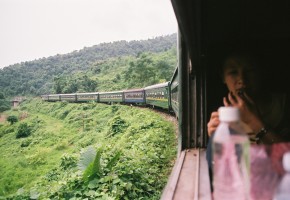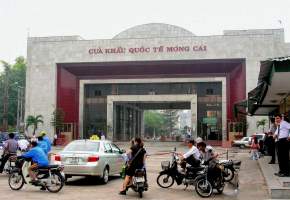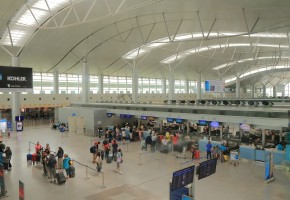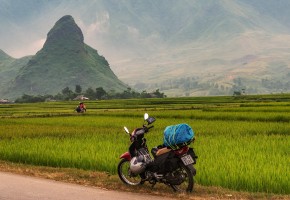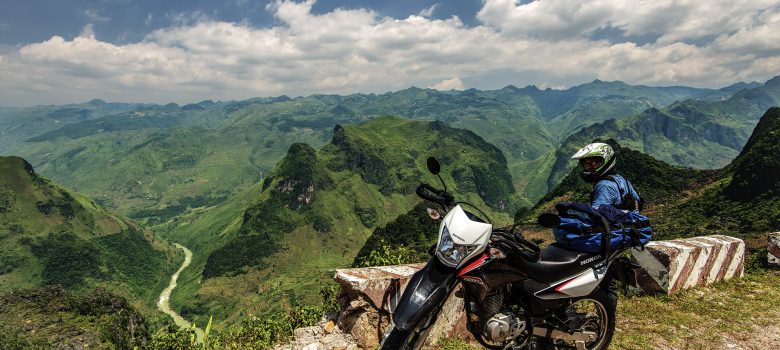
Motorbike
Overview
Vietnam, with its 200,000+ km network of roads connecting urban centers to farming villages, breathtaking mountains to beach resorts, and rugged coastlines to lush jungles, is without a doubt one of those countries that is fabulous to experience on a motorbike. It’s a two-wheel wonderland.
The country is that perfect point where secondary and rural roads are sufficiently good (mostly) that riding is a pleasure, but cars, despite their increasing numbers, are not yet dominant. Most of the local population still rides small motorbikes. Cars and trucks are therefore very motorbike-aware, but not yet so numerous that riding a motorbike feels too challenging.
We love it — the best motorbike riding in SE Asia we reckon, especially off the beaten path.
An increasing number of adventure-seeking visitors are catching on to it as well. We say, come and experience it now, before cars get dominant on secondary roads and rural road speeds increase.
Riding a motorbike in Vietnam, whether in the heaving traffic of Ho Chi Minh or Hanoi or the twisting mountain roads of Ha Giang, is not as hard as people imagine.
You need to ride safe and smart, and to do that you need to know some practical rules of the road, have the right equipment, and practice some good planning.
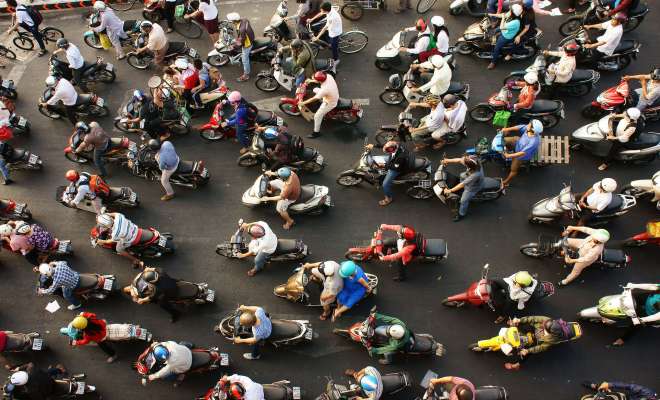
Riding safe and smart
The most important things to know about riding safe in Vietnam are to ride alert & defensively, know the basic rules of the road, keep speeds down (slower than you’re used to) to suit road & weather conditions, wear a proper helmet and some protection, and be prepared for the unexpected.
It’s also important to choose your roads carefully, and stick to the smaller roads where you can. Main roads are typically choked with trucks, buses and cars and are no fun and we think generally less safe for motorbikes.
Using secondary roads will make your trip a bit slower but far more scenic and pleasurable. Note that motorbikes are in any case prohibited on freeways and motorways — the logic being that it is too dangerous to mix large and fast with small and slower.
Riding in Vietnam is different. The most basic rule of the road is, irrespective of the law, the right of way invariably goes to the biggest vehicle on the road.
This means, for example, that motorbikes and bicycles need to regularly pull onto the highway edge to give way to trucks or buses. And larger vehicles overtaking you assume that you will pull over onto the hard shoulder to let them pass (it’s not a game of chicken – let them pass you).
In theory, people drive on the right in Vietnam. In practice vehicles large and small swoop, swerve and dodge wherever they want, using their horn as a surrogate indicator and warning of their approach. Trucks, buses, cars, motorcycles and even cyclists will come at you on the wrong side of the road.
You however should stick to driving on the right; you are more predictable that way and thus safer. And be prepared to give way or simply get off the road to anything that is large and risky and driving on the wrong side.
In principle, passing should be done on the left. But other motorbike riders and sometimes larger vehicles will (annoyingly) squeeze themselves into any passing space available, be it on the left or on the right.
No matter what others do, you should pass on the left. And otherwise keep to the far right of the driving lane (within reason), thus giving those behind you plenty of space to pass.
Legally, vehicles should give way: to the right; at T intersections; at crosswalks; at stop signs; and at traffic lights. But they often don’t, and you therefore need to drive defensively. You should obey the stop and give way laws even if others don’t — it makes you more predictable and that’s safer.
In Vietnam, you need to be alert to what is happening around you at all times — use your rear view mirrors but especially keep your eyes on the road ahead.
Many motorbikes don’t have rear view mirrors and cars, trucks and buses often don’t use them. People focus more on watching and driving to avoid collisions ahead. This is a key unwritten road rule.
Other traffic will expect you to do this. They may swerve, change speed, move across traffic with very little regard for traffic behind them — they expect drivers behind them to be watching ahead, to react and not hit them. You can see this at work especially in the big cities. It’s surprising how effective it is.
Horns are used to make other drivers aware of your presence — not just to warn of danger. Vehicles passing you will toot to let you know; they’ll assume you don’t look in your mirror. They’ll toot to simply to say they are there. You should do the same.
Buses and min-buses deserve special mention. They are usually driven by madmen and are dangerous — they mostly expect motorbikes to get out of the way and might actually hit you if you don’t. Don’t argue with these guys.
Unless otherwise stated, the speed limit is 70 kph on divided roads, 60 kph on undivided roads and 50 kph or less in towns.
Pushing the speed limit or riding too fast for the conditions is a major cause of motorcycle accidents. Especially in the hills, roads are twisty and sometimes foggy, there might be gravel or broken pavement on corners.
Lots of unexpected stuff happens. Vehicles on the wrong side of the road; a herd of cows or buffalo; children dashing out in front of you; sudden changes in road conditions.
Sensible road speeds are thus less than many Western riders are used to. Western riders have been injured and killed ignoring this.
One of the most important practical road rules for riding in Vietnam is, then, to stay within the speed limits, and never ride beyond your personal abilities or faster than conditions warrant.
Another killer is mixing riding and alcohol. The Vietnamese love their beer and rice spirits, and alcohol is a big cause of motorcycle deaths. Use your common sense on this.
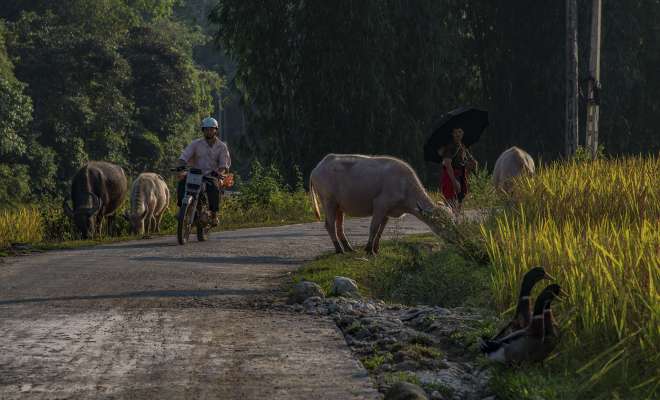
Make yourself easy to see on the road. The more visible you are, the better chance you have of other drivers seeing and avoiding you. Wear bright clothing, position yourself so other drivers can see you, and always signal before turning or changing lanes.
We also recommend extending your arm and waving your hand in the direction you are turning, for extra notification of your intention. It’s what the locals often do.
Avoid riding on the open road after dark, especially in the countryside, since many vehicles either don’t have functioning headlights or simply don’t bother to turn them on. The dangers from trucks and buses, and even animal danger, increases at night too.
We cover riding safety gear in more detail later on this page, but the key thing to summarize here is — bring a proper helmet from home if you can. It’s not easy to find a well-fitting certified helmet in Vietnam.
If you can’t bring a helmet from home, then get the best one you can find. It’s important. Most of the thin helmets worn by locals and widely available for sale are completely worthless; don’t use them. If you are taking a tour with Other Path Travel, contact us for help!
Road terminology
Every country has its own system of highways, roads, streets, boulevards, lanes, alleys, etc., and each country has its own way of naming these.
Vietnam is no exception. Understanding what the road abbreviations mean will make it easier to navigate your way around and know which roads to take or avoid.
Some types of roads are well maintained while others are simply not. Some smaller, single track road types can be really rough and are typically best avoided.
Here are the abbreviations most often seen on maps, and their meanings:
AH1 — The main north-to-south highway, generally very congested with trucks and buses, should be avoided, except possibly to save time entering and exiting cities.
QL — National roads, which are generally paved and in good condition, easy to navigate. Can still be busy with many trucks, buses & cars. We would include the less busy in our ‘secondary’ roads.
QL**b — An alternative to the primary QL road, usually more pleasant, less traveled roads that make for a better riding or driving experience. We would include these in our ‘secondary’ roads.
CT — Superhighway — no motorbikes allowed, strictly for cars, trucks, buses etc
DT — Countryside roads. If in good condition, these roads can make for wonderful riding and driving, are often less traveled, and often have great views. If in poor condition or under repair, they can be really rough and are best avoided unless you have an off-road bike or 4WD. Local knowledge might be needed to figure out if OK to ride. These are included in our ‘secondary’ roads.
TL — Very small roads, often single track, sometimes not marked on Google maps, mostly used by villagers. If a well maintained tarmac or poured concrete construction, can be superb off the beaten path roads of discovery. We include some that we know well in our Other Path Travel tours. If dirt or in need of repair, can be very challenging to all except serious off-road bikers. Often requires local knowledge to determine if OK to ride.
License requirements
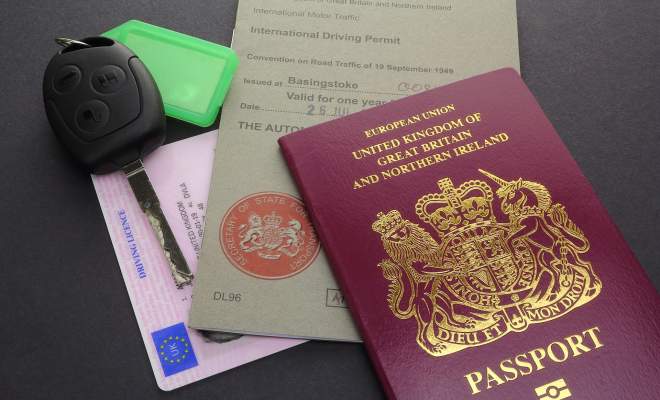
If you ride in Vietnam without a valid motorbike license not only is it illegal but you will likely not be covered by travel or medical insurance (the vast majority of insurance policies will not cover you if you are not legal).
That would be a problem because good quality medical care is expensive.
Many foreigners tend to adopt a laissez-faire attitude towards having a valid license, and just don’t bother. Most of the time foreigners will not be stopped by the police and therefore will never have to produce a driving license.
But that won’t solve the insurance issue.
We strongly recommend that you do have a motorbike license valid in Vietnam.
Foreigners from countries who are members of the Vienna Convention on Road Traffic treaty (1968), are now permitted to drive in Vietnam with an International Driving Permit (IDP). Easy.
Note that to ride a motorbike legally in Vietnam, your IDP must include motorbike classification, and the IDP must be accompanied by a valid motorcycle riding license from home. If you are licensed only to drive a car in your own country, the IDP is not valid for riding a motorbike in Vietnam.
Click here for more information on the treaty and a list of participating countries.
The treaty’s list of countries is long, but note that among others, the United States, Canada and Australia are not on this list.
Citizens of these countries must obtain a Vietnam motorcycle license on the basis of their existing motorbike driving license in order to be able to ride legally in Vietnam. It’s a bit of a process, and you should contact the Vietnamese embassy in your own country well before you leave for Vietnam. If you are taking one of our Other Path Travel tours, contact us and we will orchestrate things.
Insurance coverage
Personal medical insurance is the most important insurance that we recommend all riders have.
It needs to cover motorcycle accidents (for you as driver as well as pillion, and third party liability for any others who might be injured or have property damaged) and any associated need for medical care or hospitalization, including helicopter evacuation to the nearest hospital or major city hospital as the need may be.
If you are involved in an accident in which a Vietnamese person gets injured or whose motorbike/car gets damaged, chances are high that you will be “at fault”, even if the accident was not caused by you.
You are a foreigner, therefore you will be considered at fault – not fair, but that’s generally how it goes.
After negotiation (here is where traveling with a guide helps), you will have to pay an amount of money to cover the injured person’s costs and damages etc, depending on the severity of the injury or damage. Normally it’s a reasonable sum.
If the accident is severe enough to involve an ambulance or the police, then it’s a different ball game (here is where traveling with a guide really helps).
Trip planning
The basics
The key things to keep in mind are: keep off the major roads and use secondary roads where you can (as described above); allow extra time for changes in plans due to unexpected weather or changes in road conditions; and plan to go slower than you would at home — because of speed limits, road conditions and the art of ‘slow travel’, which we think is the whole point of riding in Vietnam.
On a typical rental motorbike such as Honda Wave or Fortune with engines around 110cc to 125cc you can expect to average around 30 km/hr to 50 km/hr. This will often be at the lower end if the roads are twisting and there are trucks and other traffic on the road that you have to wait behind until you have a decent passing opportunity.
Even if you rent a bigger 150cc to 175cc bike, which are considerably more powerful, your average speed will only increase a little, maybe a range of 35 km/hr to 6o km/hr. Slow travel is still the name of the game.
We don’t recommend hiring bikes bigger than 175cc. Many foreigners do come to Vietnam and rent larger bikes. It’s what they are used to back home.
But 150cc – 175cc is plenty of power, given Vietnam’s winding back roads, speed limits and general road conditions. A bigger bike makes sense only if you intend to spend a lot of time on major roads — and as we have described above, such roads tend to be congested with trucks, buses and cars.
If your focus is on off-road dirt riding then a 250cc might make sense. Otherwise we recommend sticking to 175cc and below.
Riding on Vietnamese roads takes a good deal of concentration, and 4 – 6 hours on a smallish bike covering 90 km to 200 km (depending on the road and number of side-trips) is a decent day’s ride. 250km would be a longish day.
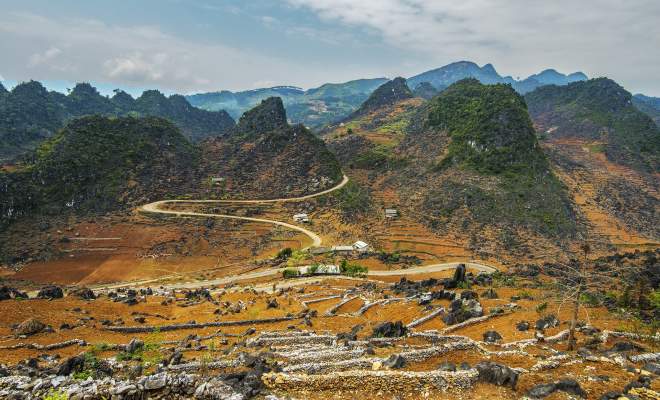
The landscapes and villages and daily life in the fields are generally so amazing and interesting that you will want to stop often. As we have said, going slowly and exploring and enjoying is the whole idea.
Back roads and side excursions are often where the best bits are — those unexpected discoveries and experiences that make a trip special and memorable.
All of this adds up to days that are shorter in terms of distance from start to destination than what you would be used to back home — but full days in Vietnam.
When you do want to cover some serious kms over less interesting bits, then one way is to store your bike in the undercarriage of a bus while you ride in air-conditioned comfort upstairs. Alternatively, you can also put your bike on a train.
Once you reach your destination, rested and relaxed, hop on the bike, get refueled, and set off for some fantastic riding.
It takes a bit of organizing to book the bike on a bus or train, and handle the on/off process at each end, which tends to be a little different for each bus / train. You’ll need to do some research and be prepared to spend some time on it. Or work through the people who you rented your bike from. Or take a tour with a company like us where we organize all such details.
You can also send your bike unaccompanied on a bus or truck or train to a city with a domestic airport and then fly to collect your bike. This is a great way to cover a lot of distance, and enables tours to be put together than involve widely separated regions. However it requires a good deal of organization and is best done through a company that is experienced in such transport. Contact us if you have a query.
Weather and the seasons vary greatly from north to south in Vietnam. Because motorbike trips depends so heavily on weather, you need to plan carefully when to go. And because the weather is so changeable and hard to forecast, you need to add contingency days into each plan. See here for more information on weather and planning in Vietnam.
Panniers and packing light
Panniers are the way to go for motorbike touring in Vietnam.
They are the easiest, most effective, least cumbersome way to carry your clothes and gear. On bikes like the Honda Wave, where the fuel cap is under the seat, leaving the seat space free of baggage eliminates the hassle of needing to untie your pack to refuel. This might not sound like much, but you’ll get to love it.
Finding panniers to fit your rented bike is difficult. Much better to get your bike from a company that provides properly fitted panniers to begin with.
All motorbikes on Other Path Travel tours come with left & right soft panniers, plus a rear luggage rack designed to take a small duffel bag attached with bungee cords, or octopus straps.
Each pannier has a capacity of about 20 kg, and they are made of waterproof material, reasonably shower-proof when riding in wet or misty weather. This should be plenty of storage for a tour of up to 12 days.
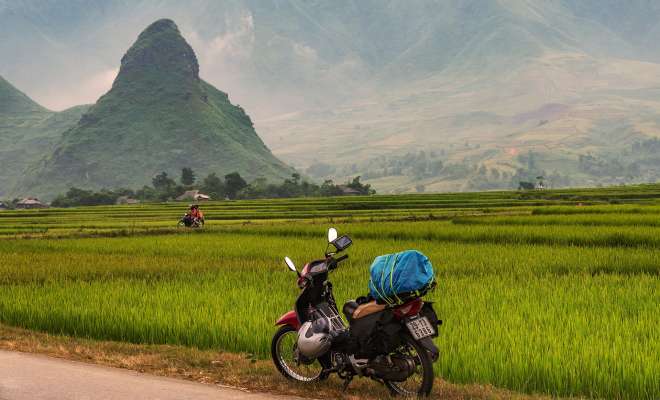
Clothing and gear
Wear and bring the right clothing and gear — you’ll be safer and a lot more comfortable.
Two things: cover up and layers.
Sliding across 20 meters of asphalt in a pair of sandals, shorts and a T-shirt will leave you with some serious road rash, or worse, serious injuries. The sun in Vietnam is often intense, so poor UV protection can lead to serious burn injuries.
We see too many young foreigners on motorbikes with inadequate clothing — and they come to grief. There have been so many injuries that the Vietnamese government has tightened motorbike rental laws to try and keep inexperienced foreigners off the roads. Riding with lots of exposed skin also marks you as seriously un-smart and uncool with the locals.
Cover up. Period. This means long pants, long sleeved shirts, closed shoes (not sandals or flip flops). Just like most of the locals.
In Vietnam, it is possible, depending on the season, to experience a variety of weather conditions in any one day, so the best approach to clothing is to be flexible and dress in layers (see here for more information on seasons and weather).
As mentioned in “What to take” , moisture-wicking travel / outdoor clothing is great for motorbiking. Modern materials are lightweight, hard-wearing, easy to launder, are often minimal-iron, offer good protection from sun and UV, and pack small. They make traveling light easy.
In summer, we recommended light weight long sleeved shirts and pants, plus hiking shoes or sneakers with adequate ankle support and a good sturdy sole. Jeans offer good protection, but if it’s too hot for jeans, we recommend protective knee pads on top of the pants.
In the mountains in the winter months of December & January, it can get really cold riding so we recommend warm layers for both torso and legs. We tend to wear a thermal base layer under other clothing. High quality merino wool tops, layered with other thin, but warm tops, are a good base to beat the often penetrating cold.
As the temperature rises and falls, which is common as we ascend and descend the mountains passes, the layers can be added or shed as needed.
Regardless of the season, you should always be prepared for rain, especially in the mountains, so a good quality rain jacket and rain pants will make your trip a more comfortable one.
Wind and waterproof rain gear based on materials like Gore-Tex will keep you dry while also allowing you to sweat, important in Vietnam’s humid climate – these days they come in lightweight versions that can pack into a small bag.
Also useful and readily available everywhere in Vietnam is a rain poncho, which provides extra body cover in prolonged rain, and because of its open design, it allows air to circulate, which is good in the heat.
Helmet & protective gear
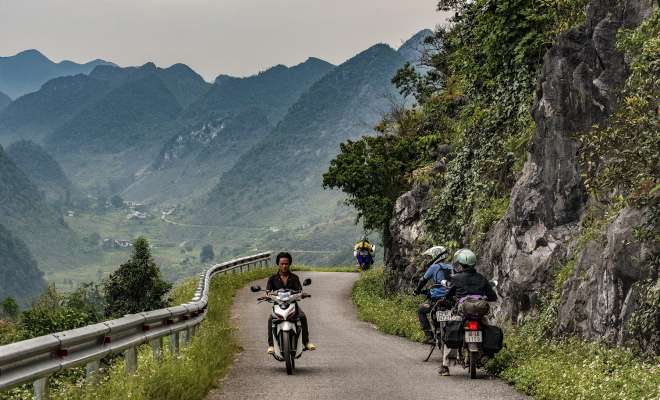
Safety first — if you can, bring a properly fitting and certified helmet with you from home. They are hard to find in Vietnam.
If you can’t bring one, then work with the people supplying your bike to get a good helmet. If they can’t help, by providing a helmet or suggesting where you can buy one, then you might want to change supplier.
Be careful buying a helmet in Vietnam — most are not properly certified to pass international protection standards. And don’t rent a helmet except from a trustworthy source — you don’t want to use a helmet that has been dropped or damaged. For our customers, Other Path Travel can purchase a good international quality new helmet for you in Hanoi to pick up at the start of your tour – please email us at least a month before your tour start date at [email protected].
Whether you wear an open-face or full-face helmet is your choice – the open-face helmet is more popular in Vietnam but both are used. The full-face helmet offers more protection, but is hotter.
With either style, your helmet should have a visor to protect against rain and insects. You should also bring a soft cloth drawstring bag to put the helmet in and protect it (especially the visor) when it needs to go into the hold of a bus or the trunk of a car or the luggage rack of a train.
Bring with you or get some riding gloves to protect your hands and knuckles — they will shield your hands from Vietnam’s intense UV too.
Heavy weight ones from home will be too hot for all but winter in the north — bring lighter weight ones from home, or you can buy OK gloves in motorbike shops in Ho Chi Minh and Hanoi. Or ask the people you are getting your bike from to help.
Elbow and knee guards are widely available in Ho Chi Minh and Hanoi bike shops. They add valuable protection to long pants and long sleeve shirts. Some people love them; others hate them because they are bulky and can be hot in summer. They are an individual choice. We think they are a good thing if you are new to riding in Vietnam.
Mesh jackets are worth considering too. These are open mesh but with shoulder and elbow pads and something for the middle of the back. Worn over long sleeve shorts, the mesh keeps them cool and airy. They are available in better motorbike shops in Ho Chi Minh and Hanoi.
Renting or buying a motorbike in Vietnam
Rent or buy? There are so many options available.
If you are planning to travel by motorbike in Vietnam for several months, then buying and selling a motorcycle rather than renting might make sense. Note that it can quite difficult taking a motorbike you have bought back and forth over the Vietnam border — we strongly advise you to fully understand the possible pitfalls before you buy a motorbike.
If you are only in Vietnam for a short period of time, then renting is probably the more logical choice.
If you choose to rent, the first thing you need to consider is renting from a reputable company.
There are countless “renters” that will gladly unburden you of your money to rent their usually not-so-great bikes, often found in the backpacker districts and touristy areas.
We suggest you stay away from these places, they are often (but not always) scammers looking for a quick buck with no regard for providing a good bike nor for your safety. It will inevitably lead to more trouble down the road than you bargained for. For more information on avoiding motorbike rental scams in Vietnam click here.
Fortunately there are some highly reputable motorbike rental places that we would be happy to introduce you to. Contact us for more information.
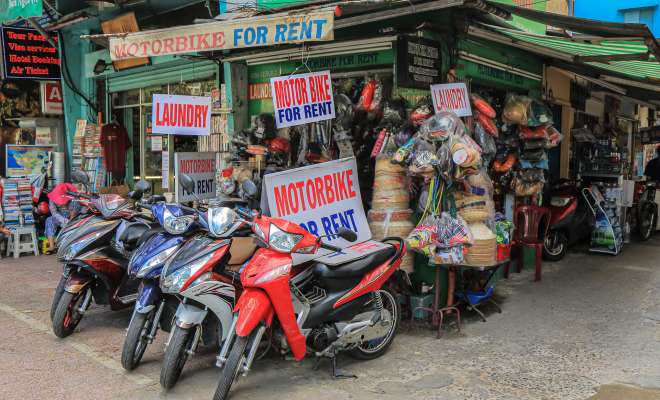
What kind of bike should you rent? Of course, your budget, the nature of your travel and the number of people traveling on the bike will be factors in choosing the type of bike you need.
If you are a keen and experienced motorbike rider back home then we suggest a fully manual 150cc bike like the Honda Winner or Yamaha Exciter. Both of these are bikes made for the Vietnamese / Asian market; they are popular and can be repaired almost anywhere. They cost about twice the rent for a Honda Wave.
If you have less experience or are simply happy to have a slightly smaller bike then we recommend something like the semi-automatic Honda Wave or Honda Fortune. The Honda Wave is one of the most popular bikes in all of Vietnam. The Fortune is slightly more powerful.
The locals ride these everywhere. Their light weight makes them easy to ride and very maneuverable; they are good on dirt roads too. For information on bike rental prices click here.
Buying a motorbike can be a less expensive (but of course, more troublesome) option. It is important to know that foreigners can not officially buy/register a bike in their own name. You need a Vietnamese person or business to do it for you.
If you want to purchase a bike, we strongly recommend you buy a second-hand, well maintained bike from a reputable seller who is in the business of selling bikes and then buying them back from you at the end of your trip. The overall cost is similar to the cost of renting.
The better sellers will also have arrangements for servicing or repairing the bike if necessary while you are traveling with it — it’s in their interests to keep the bike in good condition and a happy customer.
Do your research on sellers carefully — we’ve seen travelers with a broken down bike cursing their poor choice of seller.
You can also buy a brand new bike from one of these credited sellers, who will buy it back from you when you’re done traveling. Obviously this costs a bit more, but has many advantages and we like this option.
If you do purchase a bike, make sure that you have the registration card with you at all times. If police ask for it and you don’t have it, things can get complicated. Take photos as well so you have some evidence in case the card gets lost.
Crossing borders on a bike
If you plan to cross over to or from any of Vietnam’s neighboring countries on a motorbike, it is important to know that ‘regulations’ are constantly changing, and each border crossing has its own rules about crossings.
It is also noteworthy that getting a motorbike across the border from Vietnam to Laos or Cambodia is relatively easy, but getting it back into Vietnam can be difficult, unless you are the registered owner of the motorbike.
You need to do it right, so we encourage you to check online for the most recent border crossing information.
Or contact us.


